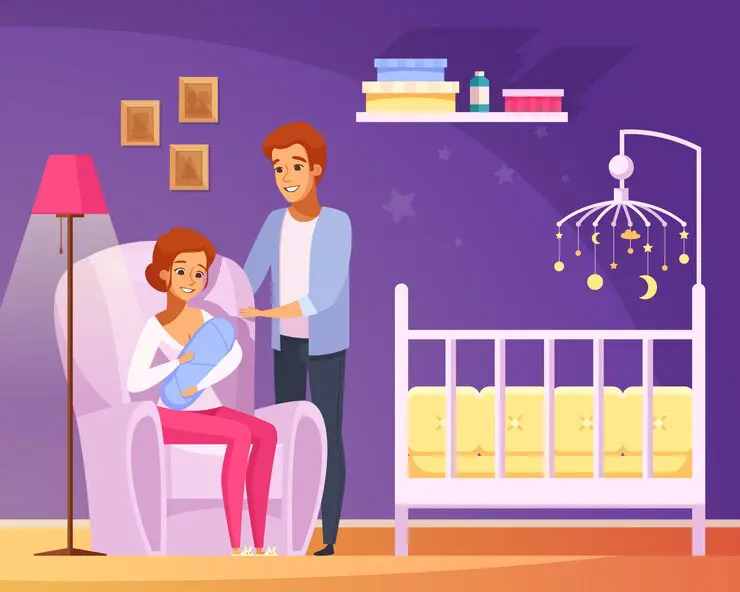It is an important question of every parent how to handle your baby standing in crib? If you have infant then you must read this article.
As your baby grows and becomes more active, it’s not uncommon for them to start standing up in their crib. While it may seem cute initially, it can also cause concern for parents. Not only can it be dangerous for the baby if they fall out of the crib, but it can also be a sign that it’s time for them to move on to a giant bed.
This blog post will discuss some tips and strategies for dealing with a baby standing in their crib. We’ll cover everything from safety precautions to transitioning to a toddler bed.
You will have the information and confidence necessary to keep your baby secure and at ease in their resting environment by the time you conclude this article.
How old was the baby when they started standing in the crib?
how to handle your baby standing in crib? Babies typically start standing in the crib around 8-12 months as they develop the ability to pull themselves up to a standing position. However, some babies may start earlier or later, depending on their development.
It’s essential to be aware of this milestone and take the necessary safety precautions to ensure that your baby is safe and secure in their sleeping space.
If you have any worries regarding the growth or security of your child, it’s a good idea to speak with your pediatrician.
Safety Tips
How to handle your baby standing in crib and safety tips for learning. Safety should always be the top priority when dealing with a baby standing in their crib. Here is some important safety advice to remember:
- Use a firm, tight-fitting crib mattress: A firm mattress will provide a solid surface for your baby to stand on, which can help prevent them from falling. It’s also essential to ensure that the bed is the proper size for the crib and fits snugly against the sides.
- Check crib hardware: Ensure all crib hardware is securely fastened and in good working condition. This includes the crib’s slats, mattress support, and other hardware used to hold the crib together.
- Remove loose items: Remove any open items or toys from the crib that the baby could use to climb out. This includes stuffed animals, pillows, and blankets.
- Use a crib tent: Crib tents are designed to fit over the crib to create a barrier preventing babies from climbing out. It keeps the child inside the crib without needing to lower it.
- Keep an eye on your baby: Always ensure you can see and hear your baby while in the crib. This means keeping the baby monitor close by and checking on your baby regularly.
It’s important to remember that a baby standing in their crib may be ready to move on to a giant bed. However, it’s still important to take the necessary safety precautions to ensure that your baby is safe and secure in their sleeping space.
Lowering the crib
Lowering the crib can be an effective solution for preventing a baby from standing and potentially climbing out of the crib. Here’s how to safely lower the crib: Read more about How to handle your baby standing in crib?
- Check for stability: Before lowering the crib, ensure it is stable and in good working condition. Check for any loose hardware or other issues that could make the crib unsafe.
- Adjust the mattress height: Most cribs have adjustable mattress heights, which allow you to lower the mattress as your baby grows. Make sure to adjust the bed to the lowest setting that is still within safety guidelines.
- Use bedding: If the crib has a drop side, you can use a folded blanket or towel to prop it up, creating a barrier that will discourage your baby from standing up.
- Use safety gates: If you cannot lower the crib and need an immediate solution, you can use a safety gate to block off the crib. This will prevent your baby from standing up or climbing out.
- Monitor your baby: Even after lowering the crib, it’s essential to monitor your baby while sleeping to ensure they are safe and secure.
It’s essential to remember that even if you lower your child’s crib, it must still fulfill safety requirements and have a minimum clearance of 26 inches between the mattress’s top and the crib rail.
It is also advisable to check the manufacturer’s recommendations before making any adjustments. Also, always consult your pediatrician if you have concerns about your baby’s safety in their crib.
Practice Time During the Day
How to handle your baby standing in crib? Providing your child with lots of practice time during the day can help them to develop the physical strength and coordination needed to stand in the crib. Here are some ways to provide practice time:
- Tummy time: Place your baby on their stomach for short periods each day. This will help them develop the muscles in their back, neck, and shoulders needed to pull themselves up to a standing position.
- Playtime: Encourage your child to play and explore their environment. This will help them to develop the fine and gross motor skills needed to stand in the crib.
- Crawling: Encourage your child to crawl around. It also helps them to build strength and coordination in their arms and legs.
- Standing: Hold your child’s hands and help them to stand up. They may practice standing this way, giving them the confidence they need to stand alone.
- Provide safe toys: Provide your child with toys to pull up on and practice standing.
It’s important to note that every child develops at their own pace, and forcing or rushing them to stand unnecessary. Also, it’s essential to provide a safe environment for them to practice, ensure that the area is free of hazards, and always supervise your child during practice.
Transitioning to a toddler bed
Transitioning your baby to a toddler bed can be an excellent solution for dealing with a baby standing in their crib. The following advice will help the move go as smoothly as possible:
- Timing: The ideal time to transition your baby to a toddler bed is when they are around 18 months old and ready to climb out of their crib.
- Use a bed rail: A bed rail can provide a barrier that will prevent your baby from falling out of the bed.
- Keep familiar bedding: Using regular bedding and blankets can help make the transition to a toddler bed more comfortable for your baby.
- Make it fun: Use stickers, decals, or other decorations to make the new bed look fun and exciting for your baby.
- Be consistent: Establish a bedtime routine that includes reading a story, singing a lullaby, or any other bedtime rituals you have.
- Be patient: Your baby may have difficulty adjusting to the new bed, so it’s essential to be patient and understanding. Your infant could need a few weeks to adjust to the new bed and feel at ease.
When transitioning from a crib to a toddler bed, keep in mind that the bed must still meet safety standards and have a minimum height of 26 inches between the top of the mattress and the top of the bed rail. Also, always consult your pediatrician if you have concerns about your baby’s safety in their new bed.
Don’t try to prevent your baby from standing.
It is natural for babies to start standing in their crib as they develop the physical ability to pull themselves up to a standing position. While it can be concerning for parents to see their baby standing in the crib, it is essential to remember that it is a normal developmental milestone.
Instead of trying to prevent your baby from standing in its crib, there are steps you can take to ensure its safety.
It’s important to lower the crib mattress to its lowest position in order to stop your child from climbing out. In order to establish a barrier that will stop your baby from falling out of the crib, you may also use crib tents or mesh liners.
It is also essential to ensure your baby’s crib is in good working condition, has no loose or missing parts, and meets safety standards.
Additionally, transitioning to a toddler bed may be a solution for your baby standing in the crib. It’s important to plan ahead, make sure your kid is ready for the transition, and make sure the bed conforms with safety standards and measures at least 26 inches from the top of the mattress to the top of the bed rail.
It’s also important to remember that every child develops at their own pace, and forcing or rushing them to stand is not necessary. Always consult your pediatrician if you have concerns about your baby’s safety.
Conclusion
In conclusion, it’s normal for a baby to start standing up in their crib. However, it’s essential to take the necessary safety precautions to ensure that your baby is safe and secure in their sleeping space. You can lower the crib, use a crib tent, or even consider transitioning to a toddler bed.
It’s essential to keep an eye on your baby and ensure the crib or bed is in good working condition and meets safety standards. Always consult your pediatrician if you have concerns about your baby’s safety. You can ensure that your baby is secure and comfortable while they sleep by following a few easy procedures.





